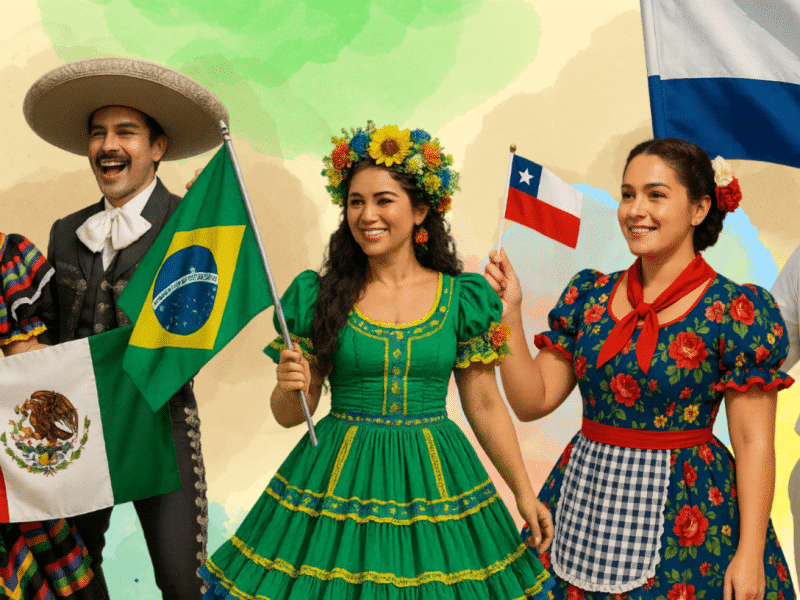Afro and Black Latino Identity Is Complex, But Media Keeps Getting It Wrong
The African diaspora has shaped every corner of the world, including Latin America. Despite attempts to deny it, Black history is deeply woven into the fabric of our culture and identity.
Media Continues to Reinforce Deeply Inaccurate Stereotypes
Many Latinos who don’t appear stereotypically “Latino” deal with having their race questioned fairly often. Most educated people don’t need to be reminded that the United States doesn’t have a welcoming history for people of races other than white. Therefore race, ethnicity, and identity that is non-white have simply been pushed into the othered “non-white” category. For Latinos, this is particularly challenging because, by most standards, Latino isn’t a race and is considered an ethnicity.
Yet many Latinos still struggle with race and identity because while Latino is debated as a race, Latinos of various races present as they are, thus confusing non-Latinos whose only familiarity with the community is through stereotypes. Any internet search of what a Latino person “looks like” will confirm the utter and total inaccuracy of what Latinos actually look like.

Google search of “latino person” shows mostly brown and lighter-skinned people.
Black Latinos and Afro-Latinos are probably misunderstood the most because mainstream media has done an abysmal job of accurately including them in media narratives. Thus, most people don’t know that Latinos come in all shapes, sizes, and skin colors, which includes Black skin. According to the Pew Research Center, about 6 million Latinos in the U.S. identify as Afro-Latino, making up about 2% of the adult population and 12% of the adult Latino population in the U.S.
The topic of Latino identity and what Latinidad means, particularly in America, is multi-dimensional and ever-evolving. The community as a collective can’t even decide what they want to be called – and maybe that’s a good thing, because if non-Latinos want a single label, they won’t ever do the work of learning the cultural and racial diversity that makes the concept of Latinidad so unique. Being Latino in the U.S. means more than just an outward appearance; it means culture, language, ancestry, geographical roots, and so much more.
The Erasure of Black and Afro-Latinos in Media
For decades, the media has portrayed a specific image of what a Latino “looks” like. Unsurprisingly, that image is lighter-skinned Latinos like Sofia Vergara, Salma Hayek, and Jennifer Lopez.
Researcher Keara K. Goin noted in her research paper in the “Afrolatinidad” subsection, “Popularly imagined as a homogenous “brown” race with a mixed Indigenous and Spanish ethnoracial heritage, the extreme diversity within the Latinx population is systematically flattened, ignored, and erased.”
In his Times article, Andrew R. Chow looked at how Afro-Latino actors continue to struggle against Latino stereotypes and discrimination. He points out that “Afro-Latino actors are consistently shut out of roles because they don’t match that image—and when they are cast, it’s even rarer that they get to play Afro-Latino characters, instead playing characters who are Black or mixed race but not Latino.”
The lack of Afro-Latino acknowledgment has its cultural and literal roots in Latin America, where being Afro-Latino comes with displacement and exclusion. It’s painfully apparent in Spanish-language entertainment where non-white actors are rarely cast, much less Afro-Latino actors, opting instead to uphold harmful Western beauty standards and colorism by exclusively hiring actors that are either white or very white-passing.
The Need for Consciousness in Making Change
Changing this narrative is far from easy, but it takes creating consciousness first. Starting with learning and accepting that Latinos aren’t just one race, Latinos are different races, and Afro-Latinos are a significant and crucial part of the community. Therefore we must continue to advocate for Afro-Latino inclusion and representation. Hollywood has made some progress in the representation of Afro-Latinos, but not nearly enough.
The 2023 Nielsen Representation Study revealed that Afro-Latino men had only 0.1% on-screen representation in 2023, while Afro-Latinas were slightly better represented at 0.7%. This is still significantly low considering the estimated 6 million Afro-Latinos in the U.S. The study also revealed that 81% of Afro-Latinos feel misrepresented in the media.
In an interview with Latin Times, Nielsen’s Senior VP for Diverse Initiatives and Insights, Stacie de Armas, stated, “Something important to point out is that they [Afro-Latinos] not only feel underrepresented. They literally are. When we look at representation data in inclusion analytics, Afro Latinos are virtually invisible in content, next to only Indigenous people. This has essentially led to the erasure of Afro Latino stories and narratives and representation in Media.”
From 2007 to 2018, only six lead or co-lead roles were portrayed by Afro-Latino actors across 1,300 top-grossing films. This long-standing issue of underrepresentation seems to be costing the industry billions of dollars. In 2024, The Latino Donor Collaborative’s report suggested that achieving proper Latino representation could generate an additional $12 billion to $18 billion a year for the entertainment industry.
But the reality is that Afro-Latinos are still too often cast aside or told they should be playing Black characters rather than Latino characters because they don’t “fit” into that role. Increasing Afro-Latino representation is critical in order to continue expanding the understanding of the truth breadth of the Latino community.
Now, more than ever, is the time to support independent Latina-owned media—your source for trustworthy news, authentic stories, and combating misinformation about our community. A gift of $25 or whatever you can will help us keep these stories alive.
Together, we amplify truth. Together, we ignite change. #AmplifyLatinoTruth, donate today.




